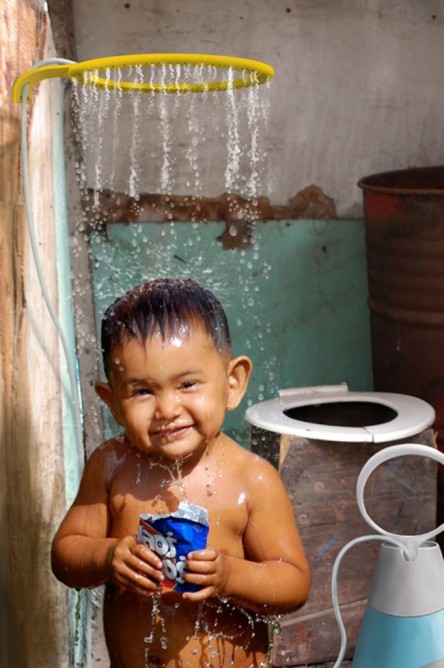Few people would think of a shower as a tool to inspire and empowering the developing world, yet this is exactly the approach my student design team took in the slums of Chile and Argentina. During the summer of 2009, twelve students from varying disciplines (graphics, environmental, product design and graduate film) were selected to take on a collaborative product design project addressing water related issues in the slums of Chile. The collaboration was entitled Safe Agua Chile and thus far three of the projects have made it to some form of implementation in Latin American countries including the DIY product design: the Ducha Halo.
We were lucky enough to have a partnering NGO, Un Techo para Chile, that not only helped introduce us to the slum communities that we’d be working with but also stayed continually invested in seeing the projects to succession.
This NGO flew us down to the slums of San Jose, Santiago, Chile so that we could better conduct observational and ethnographic field research. I’ve done social projects in the past where this component was missing, and in comparison we were not able to reach the level of depth that we were with the Safe Agua project. This research trip was essentially what took this project from hypothetical problem solving to real life problem solving.
My partner, Jessica Yeh, and I took on bathing and heating issues commonly found in these slums. Mothers often complained of children falling ill due to bathing in the cold of winter, and several times they ended up going to school dirty from skipped baths living in shame that they lived in a community that had no running water. After weeks of development, we had three functional prototypes to help us determine what solution would best fit address the issue at hand. We had developed the Ducha Halo, an affordable pressurized shower system to bring dignity and a warm shower to the slums of Latin America. Being able to prove your concept is of utmost importance, especially when it comes to projects of social impact where user validation from the field is key. This is why the DIY version was so important. We were able to pass out instructions and have hundreds if not thousands of people in Chile test our concept while we were still in the US. In Argentina we tried selling the product, to see if families would be willing to pay for this solution, also a big validation point.
The NGO has remained a partner in this process, doing all the leg work, monitoring the progress, and giving us any feedback that comes their way. Several projects in the socent space have made the mistake of assuming that adoption means success, only to find out later down the line it that the product wasn’t doing its job as well as expected. Though we have impacted so many lives already, we recognize that this is still merely in the validation phase, and there may be improvements to be made, or even the need to reconsider the design all together.
Now we are in talks with a large company that has seen the true potential of our product and the impact we’ve already have to get a production version of our product out to developing communities all over the world. We are not yet convinced this is the solution for addressing the bathing and hygiene issues of the developing world, but everyday is a new lesson to solving that problem.
Narbeh Dereghishian (article author and photos) is a product designer.

